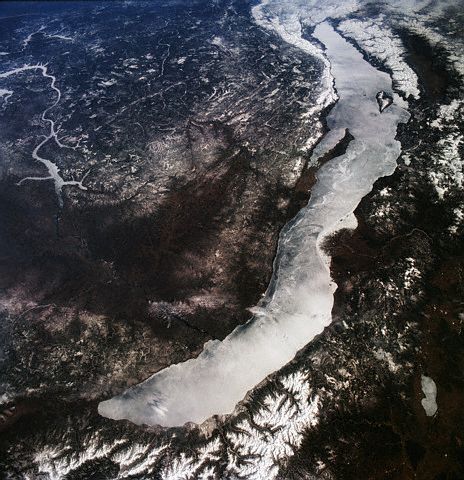| Origin & Development | |
|
Legends & Fairy tales • Earth's Crust Thickness • Underwater Relief • Landscapes • History & Formation • Seismic Activity • | |
| History of Lake Baikal | |
|
History of Explorations • Inhabitants & Settlers • First maps of Baikal • Archaeological Sites • | |
| Lake Baikal Climate | |
|
Introduction • Fogs • Winds & Waves • Ice Conditions • | |
| Fauna & Vegetation | |
|
Mammals • Baikal seal - Nerpa • Ichthyofauna • Invertebrates • Vegetation • | |
| Water of Lake Baikal | |
|
Colour • Transparency • Temperature • Pressure • Depth • Currents • Budget • Chemical Composition • Pollution • | |
| Recreational Areas | |
|
Circumbaikal Railway • Peschanaya Bays • Olkhon Island • Chivirkuysky Gulf • Wooden Irkutsk • Trans-Siberian Railway • | |
| People of Lake Baikal | |
|
People of Siberia • Buryat nation in Baikal • Russians in Baikal • | |
|
| |
| Destination: Lake Baikal / Siberia Lake Baikal is a unique natural formation on the Earth. There is no inquisitive man on the Planet who has not heard that in Siberia there is a wonder - Lake Baikal. But how well we are informed about this huge beautiful lake? It is known, that Lake Baikal differs with its original peculiarities from other world's freshwater lakes. It is the deepest (more than 1642 m) continental water-body on the Planet and contains 23,600 km2 of water or about 20% of the Earth's unfrozen surface freshwaters. The bottom of the lake is 1182 m bellow the level of the world ocean. The Baikal waters have an exclusive transparency (that is maximum in general for lakes) and minimum mineralization and suspended particles of various composition. An outstanding feature of Lake Baikal, consisting in both riches and originality of its fauna and flora, attracts attention of experts all around the world. 80% of 2635 known species and subspecies of hydrobionts in the lake are found nowhere else, that means they are endemic. But there are many other quantitative characteristics of the Lake which surprise with their unique parameters. For example, who knows (except of specialists, of course) that 300,000,000 omuls and about 100,000 Baikal seals inhabit the lake. It also seems to be unusual: such a great number of virus microorganisms living in the surface water layer and reaching n x 106 particles per 1 ml of water, or the number of cianobacteria which constitute up to 7 x 10s cells per 1 mg of water.  There is another one remarkable feature that distinguishes it from the other geological structures of the Globe. Thus if we add the highest altitude of the mountain ranges that border the lake (2840 m) to its maximum depth (1642 m) and to an estimated maximum sediment thickness of the Baikal basin (8500 m) we will find that the amplitude of the Earth's Crust trough under the lake (12977 m) is about 2 km. deeper than the deepest point of the ocean floor - Mariana Trench (11022 m). Such deep rift faults were found nowhere else on the Earth's continents. "Glorious Sea, Sacred Baikal". The words of this popular folksong have been known for more than a century. There are quite a number of seas in this country: The Black Sea, the White Sea, the Baltic Sea, the Caspian Sea. But none of them has ever been honoured with such poetic, tender words as "glorious sea". Only this, Baikal the Father, the Siberian Lake - Sea has. One should not just measure Baikal, for instance as "one fifth of the world's fresh water reserves". Lake Baikal is not a mere reservoir that contains H2O. First and foremost it is an ineffable miracle on a scale which amazes and defies comprehension. And though all reference-books define it as a "lake", the word "sea" comes to mind when looking at Baikal. Its dimensions cannot but impress, and the figures are not sufficient enough to convey what one really feels on its shores. Swiftly roaring down high ridges to the lake, many streams and rivers have cut through the mountains deep, narrow, dark canyons. In the places where the streams come across hard rock ledges they make up picturesque cascades. On the steep slopes to the height of 600-800 m above the lake level the taiga rises. Up the slope, forests are replaced by sparse growth of trees and higher up stretches out the tundra. The water of the lake is distinguished by its extraordinary clarity and cleanness. The colour of the water depends greatly on this clarity. The deepwater area of the Lake is indigo like that of deep seas, with the decrease of clarity the water gets bluish-greenish and in August - September at the time of plankton growth it becomes greenish-grey. The fishermen usually call such waters "white" or "grey", and transparent waters they would call "golomyannye" (as transparent as golomyanka fish, the endemic fish of Baikal). Throughout the immense time of its existence Baikal, sheltering a unique community of life, has outlived many other natural phenomena. It does not cease to surprise explorers step by step revealing its mysteries and astonishing them with new riddles. |